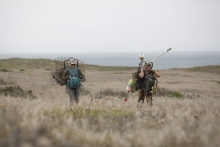By Michaela Miller, Marine Debris Project Coordinator | Santa Rosa Island Research Station, CSUCI

The Channel Islands are found in the Santa Barbara Channel in Southern California. Although the heavily urbanized mainland coastline of the Channel is home to over 18 million people, the shorelines of the islands are rugged, isolated, and provide critical habitat for endangered birds, foxes, plants, and more that are only found here. Although uninhabited, these sensitive island shorelines are plagued by large amounts of marine debris that vary in type from consumer debris like food packaging to fishing nets.In an effort to tackle this debris, California State University Channel Island’s (CSUCI) Santa Rosa Island Research Station (SRIRS) staff, faculty, and students have been working to monitor and remove marine debris from portions of Santa Rosa and Santa Cruz Islands since 2015. With support from the NOAA Marine Debris Program, over 3,000 pounds of debris have been removed from the islands, but it is no easy feat.